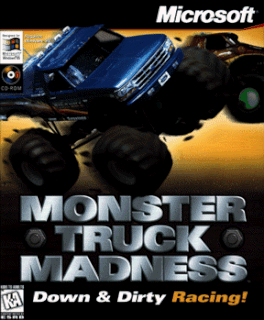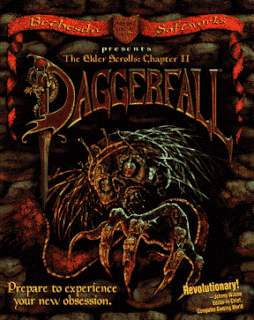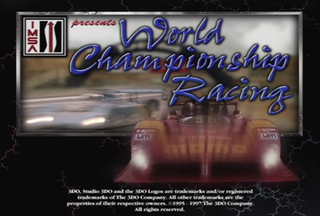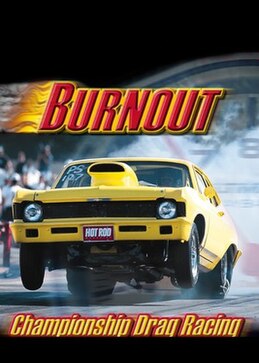Related Research Articles
Bethesda Softworks LLC is an American video game publisher based in Rockville, Maryland. The company was founded by Christopher Weaver in 1986 as a division of Media Technology Limited, and in 1999 became a subsidiary of ZeniMax Media. In its first fifteen years, it was a video game developer and self-published its titles. In 2001, Bethesda spun off its own in-house development team into Bethesda Game Studios, and Bethesda Softworks retained only its publishing function. In 2021, Microsoft purchased ZeniMax, maintaining that the company will continue to operate as a separate business.

Racing games are a video game genre in which the player participates in a racing competition. They may be based on anything from real-world racing leagues to fantastical settings. They are distributed along a spectrum between simulations and simplified arcade-style racing games. Go-kart racing games emerged in the 1990s as a popular sub-genre of the latter. Racing games may also fall under the category of sports games.
The Elder Scrolls is a series of action role-playing video games primarily developed by Bethesda Game Studios and published by Bethesda Softworks. The series focuses on free-form gameplay in a detailed open world. Morrowind, Oblivion and Skyrim all won Game of the Year awards from multiple outlets. The series has sold more than 58 million copies worldwide.

Rock n' Roll Racing is a vehicular combat-based racing video game developed by Silicon & Synapse and published by Interplay Productions for the Super Nintendo Entertainment System in 1993 and the Mega Drive/Genesis in 1994. The game prominently features a number of popular heavy metal and rock songs in its soundtrack, hence the game's title. The game was ported to the Game Boy Advance in 2003. In celebration of the company's 30th anniversary, Rock n' Roll Racing was re-released for Microsoft Windows, Nintendo Switch, PlayStation 4 and Xbox One as part of the "Blizzard Arcade Collection" in February 2021.

Sega Rally Championship is a 1994 racing video game developed by Sega AM3 and published by Sega. Originally released for arcades using the Sega Model 2 board, it was ported over to the Sega Saturn in 1995 and Windows in 1997. The unique selling point of Sega Rally Championship was the ability to drive on different surfaces, with different friction properties, with the car's handling changing accordingly. As the first racing game to incorporate this feature, Sega Rally Championship is considered to be one of the milestones in the evolution of the racing game genre. It was also an early rally racing game and featured cooperative gameplay alongside the usual competitive multiplayer.
Free look describes the ability to move a mouse, joystick, analogue stick, or D-pad to rotate the player character's view in video games. It is almost always used for 3D game engines, and has been included on role-playing video games, real-time strategy games, third-person shooters, first-person shooters, racing games, and flight simulators. Free look is nearly universal in modern games, but it was one of the significant technical breakthroughs of mid-1990s first-person perspective games. Many modern console games dedicate one of the several analogue sticks on the gamepad entirely to rotating the view, where as some older console games, when gamepads usually had fewer or only a single D-pad or analogue stick, had a feature where the single D-pad or analogue stick would move the view instead of the character whilst the player held down another button at the same time, often labelled in game as the "look button".
Criterion Games is a British video game developer based in Guildford. Founded in January 1996 as a division of Criterion Software, it was owned by Canon Inc. until Criterion Software was sold to Electronic Arts in October 2004. Many of Criterion Games' titles were built on the RenderWare engine, which Criterion Software developed. Notable games developed by Criterion Games include racing video games in the Burnout and Need for Speed series. As of April 2017, Criterion Games employ approximately 90 people.

Official Xbox Magazine was a British monthly video game magazine which started in November 2001 around the launch of the original Xbox. A preview issue was released at E3 2001, with another preview issue in November 2001. The magazine was bundled with a disc that included game demos, preview videos and trailers, and other content, such as game or Xbox updates and free gamerpics. The discs also provided the software for the Xbox 360 for backward compatibility of original Xbox games for those without broadband and Xbox Live access. As of January 2012, OXM no longer includes a demo disc. In mid-2014, the U.S. version was merged into the UK version on the website, which lasted only a few months until Future plc announced that it was closing its website along with all the other websites that Future has published, including Edge and Computer and Video Games. In February 2015, OXM and all of Future's video game websites were redirected into GamesRadar.

Monster Truck Madness is a racing video game developed by Terminal Reality and published by Microsoft, released in North America on August 31, 1996. The game has twelve monster trucks and tasks the player with beating computer opponents. Checkpoints, multiple hidden shortcuts, and interactable objects commonly appear in the tracks. In the garage, the player modifies the truck to account for terrain surfaces. Online multiplayer is accessed with a modem, a local area network (LAN), or TCP/IP.

The Elder Scrolls: Arena is an action role-playing video game developed and published by Bethesda Softworks. The first game in the Elder Scrolls series, it was released for MS-DOS on March 25, 1994. Like its sequels, Arena takes place on the continent of Tamriel, complete with wilderness, dungeons, and a spell creation system that allows players to mix various spell effects.

The Elder Scrolls II: Daggerfall is an open-world action role-playing video game published and developed by Bethesda Softworks. The second game in the Elder Scrolls series, it was released on September 20, 1996. It was both a critical and commercial success on launch. As a way to commemorate the fifteenth anniversary of The Elder Scrolls franchise, the game was made free to download on Bethesda's website on July 9, 2009.

A burnout is the practice of keeping a vehicle stationary and spinning its wheels, causing the tires to heat up and smoke due to friction.

Todd Andrew Howard is an American video game designer, director, and producer. He serves as director and executive producer at Bethesda Game Studios, where he has led the development of the Fallout and The Elder Scrolls series.

Skynet is a computer game based on the Terminator media franchise. It was intended as an expansion pack for the predecessor The Terminator: Future Shock, but was adapted into a standalone product. The game was developed and published by Bethesda Softworks in 1996.

The Creation Engine is a 3D video game engine created by Bethesda Game Studios based on the Gamebryo engine. The Creation Engine has been used to create role-playing video games such as The Elder Scrolls V: Skyrim, Fallout 4, and Fallout 76.

The Courage C41 was a sports prototype racing car built by Courage Compétition in 1994, and used in international sports car races from 1995 until 1999. Designed by Paolo Catone, it initially used a 5-litre Chevrolet V8 engine, developed by Comptech, and later used the 3-litre twin-turbocharged flat-six engine from a Porsche 935, as well as an Oldsmobile V8. In 1998, two of the C41s were developed into the Courage C51, which used a 3-litre twin-turbocharged Nissan VRH35Z V8 engine, and was used in that year's 24 Hours of Le Mans. In 1999, the C41s were mostly converted to the C52 specification ; this initially used a 3.5-litre twin-turbocharged Nissan VRH35L V8, which was then replaced by a 3.2-litre twin-turbocharged Peugeot A32 V6 engine for 2000. In 2000, the C41 line was replaced by the new C60.

Super Burnout is a motorcycle racing video game developed by French studio Shen Technologies SARL and co-published by Atari Corporation and Virtual Xperience exclusively for the Atari Jaguar in North America and Europe in July 1995. It was also published in Japan by Messe Sansao during the same period. It is the first title to be created by Shen Technologies.

IMSA World Championship Racing is an unreleased sports prototype racing video game that was in development and planned to be published by Studio 3DO on a scheduled fall 1997 release date exclusively for the Panasonic M2. Had it been released before the launch of the console was cancelled, it would have become the first officially licensed title by the International Motor Sports Association and one of the first titles to be launched alongside the system.

Burnout: Championship Drag Racing, also known as simply Burnout, is a video game developed by MediaTech West and published by Bethesda Softworks for MS-DOS, released on March 20, 1998. A Player's Choice Edition was released in late 1998 for both DOS and Microsoft Windows. Burnout was licensed by the Hot Rod magazine.
References
- ↑ Miller, Matt (26 December 2010). "Decrypting The Elder Scrolls". GameInformer. Retrieved 9 May 2011.
- ↑ "3D Realms". Next Generation . Imagine Media (10): 99. October 1995.
- ↑ Buttars, Shaffer (May 8, 1998). "Burnout Championship Drag Racing Review". gamezilla.com. Archived from the original on February 8, 2002. Retrieved April 26, 2020.
- ↑ Giovetti, Al (September 1996). "The 10th Planet Preview". Computer Games Magazine . pp. 20–22. Retrieved April 15, 2020.